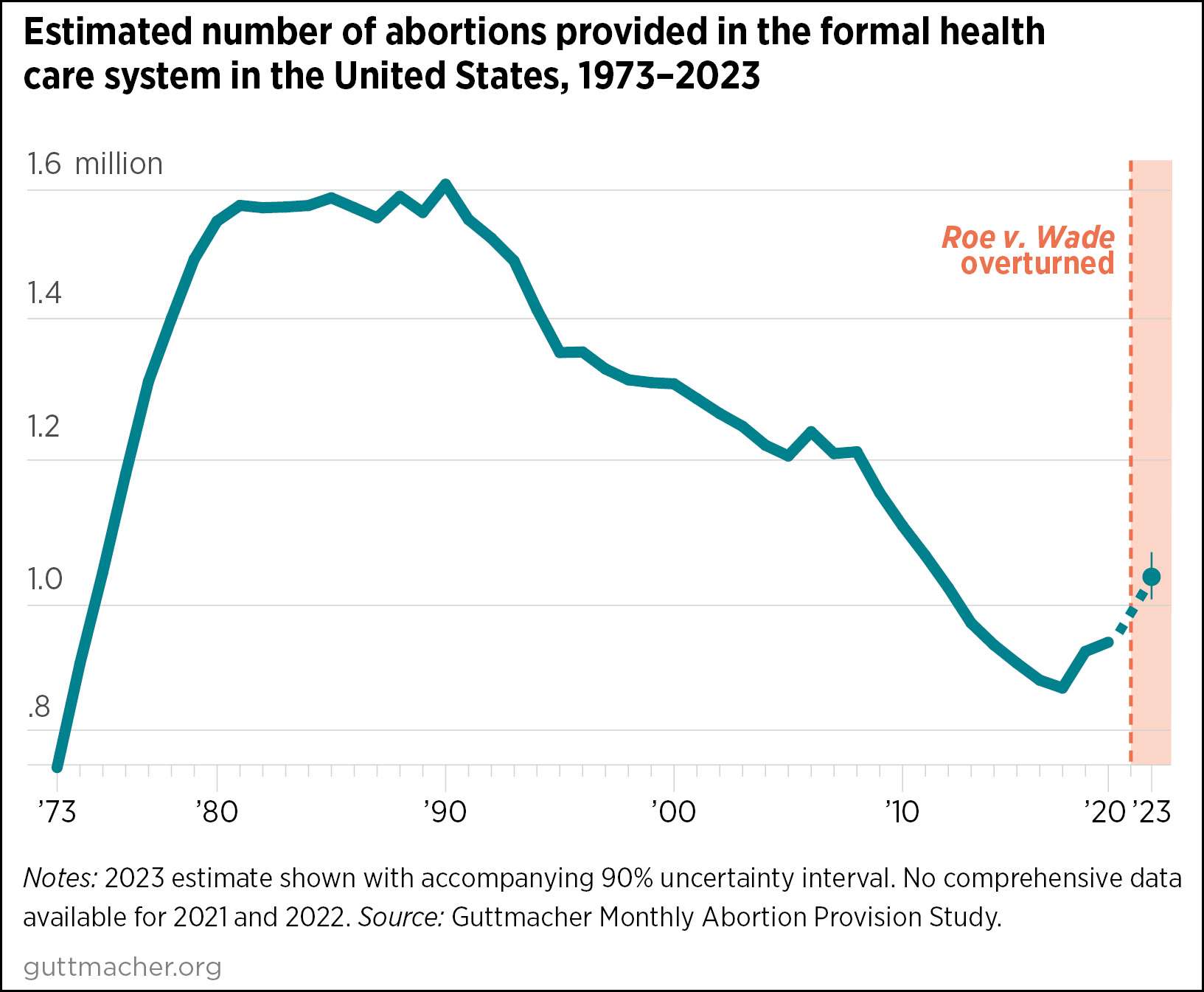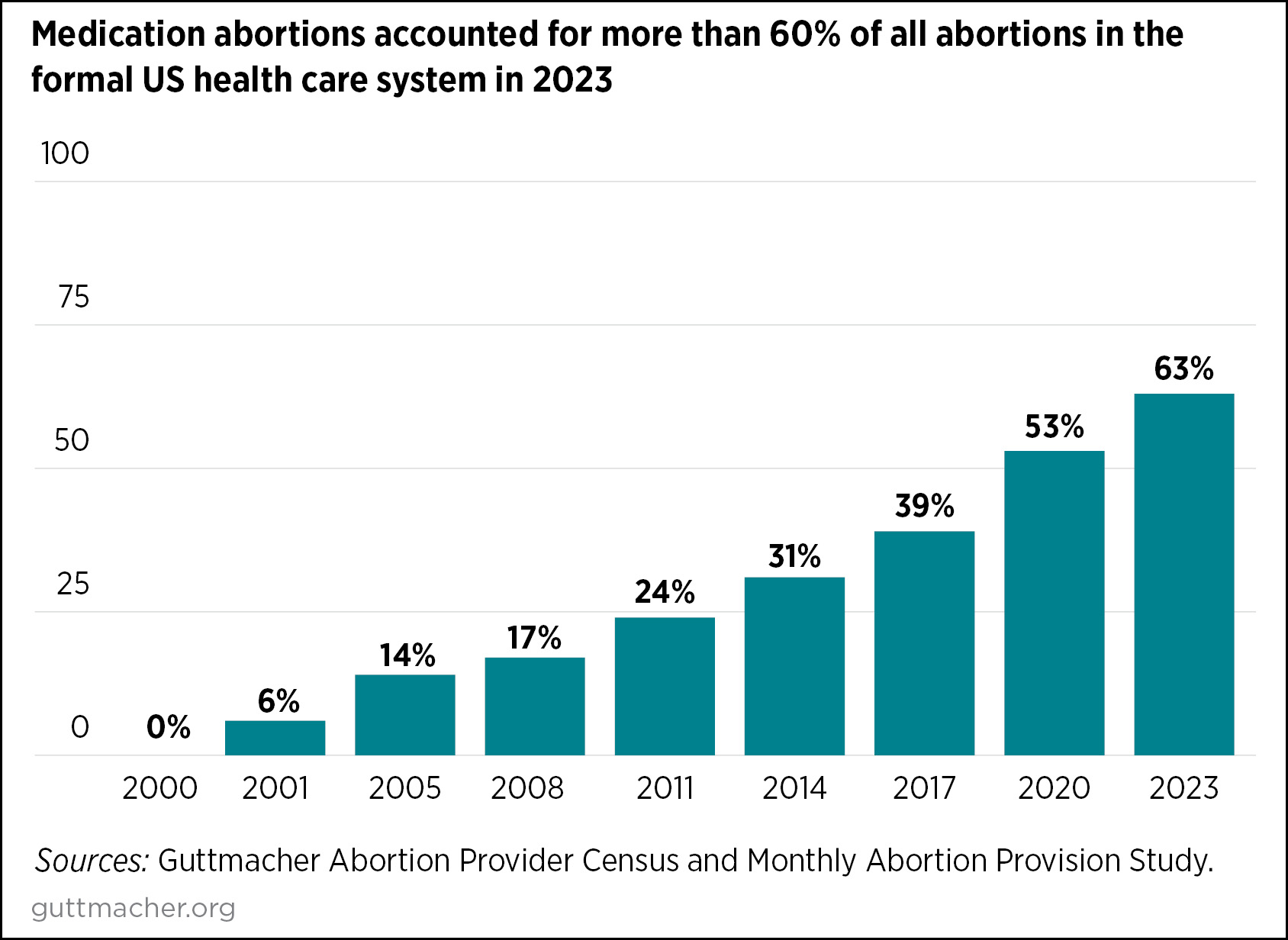The Guttmacher Institute released numbers today for abortion in 2023. They're from a new monthly survey that isn't as precise as Guttmacher's usual annual abortion count, but probably still pretty close. The figures are startling:
 This is a 10% increase from 2020. A big part of the reason is the rise in medication abortions:
This is a 10% increase from 2020. A big part of the reason is the rise in medication abortions:
 If the 2023 numbers are accurate, they suggest that the Dobbs decision had little or no effect on the abortion rate. Abortion rates went down in some states but rose in others, and medication abortions became more widely used in states where abortion has been banned.
If the 2023 numbers are accurate, they suggest that the Dobbs decision had little or no effect on the abortion rate. Abortion rates went down in some states but rose in others, and medication abortions became more widely used in states where abortion has been banned.
Aside from Dobbs, these numbers raise another question: Why did the long decline in the abortion rate suddenly turn around at the start of the Trump era in 2017? The number of annual abortions has increased 19% since then. It doesn't seem likely this has anything to do with Trump, but......

Were there simply that many more pregnancies because people got in the habit of not using condoms during covid?
Because guys who are nuts about the mask probably extend that love to the glove?
Despite Kevin’s “statistics”, the economy still sucks, especially for people in their 20s and 30s. Kids are not a good idea when you can’t afford a bigger house in a good school district. Plus, Roe being overturned has caused a ton of abortion info to appear; my favorite bar stocks the bathroom with abortion access pamphlets.So terrible time to have kids + more info about abortion = more abortions.
Damn Lies! Got any facts to back up your dopey assertion?
Despite Kevin’s “statistics”, the economy still sucks, especially for people in their 20s and 30s.
Statistical information doesn't merit scare quotes. Your unssuported assertions and anecdotes, on the other hand...
Who would want to raise a child in a country that would elect Trump?
Yeah. Unlike the "I don't care about facts, the economy sucks 'cuz I'm unhappy" (comment above) this is 100% spot on.
That was my first thought. The idea that Americans are less likely to want to bring children into the world when that monster is in the White House feels intuitive.
"Why did the long decline in the abortion rate suddenly turn around at the start of the Trump era in 2017?"
Who would want their kids to grow up in the era of tЯumpism?
Is the backwards R supposed to be a reference to Russia? If so, you should know that the Cyrillic letter in question is actually pronounced "ya". So, tya-umpism?
It's all about the ease of care. From the article: "Medication Abortion Has Become More Widely Available
For many people, medication abortion is more accessible than a procedural abortion. In 2021 (the most recent year with available data), 40% of facilities known to provide abortion care offered only medication abortion. And, starting in 2021, the FDA lifted medically unnecessary restrictions that had required in-person provision of mifepristone. That regulation change, which the FDA finalized in January 2023, meant that health care providers and online pharmacies could mail abortion medication to patients, including those who live far from a provider or are otherwise unable to make an in-person visit. In addition, brick-and-mortar pharmacies can now become certified to dispense and fill mifepristone prescriptions, so access is expected to continue growing."
👍👍👍👍👍
I'd be interested in seeing state-level crosstabs, county if they exist.
I rather suspect part of it is salience, especially in red states. Everyone is talking about abortion more; pregnant people who may not have considered it previously may be doing so now.
No such thing as bad publicity.
Here's a theory for why "the long decline in the abortion rate suddenly turn[ed] around at the start of the Trump era in 2017": Trump totally destroyed any moral credibility the right had on this issue.
Also, that factor combined with the phenomenon where gun sales increase during Democratic administrations. It's not quite the same mechanism because obviously, getting and abortion is more ad hoc than buying a gun, BUT I think Trump's being in office gave the issue more salience, which mobilized the pro-choice movement to meet demand for abortion (both through increased funding and better logistics).